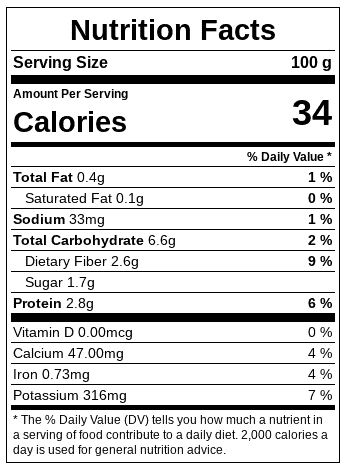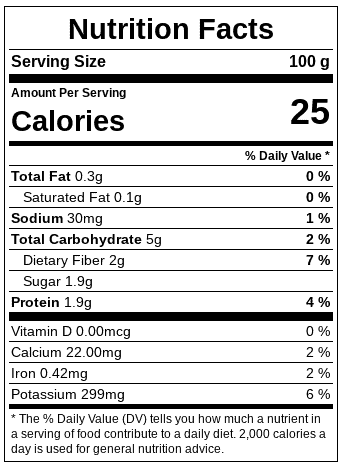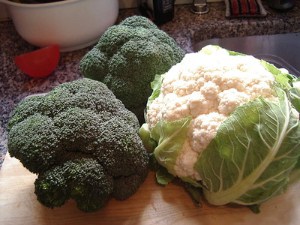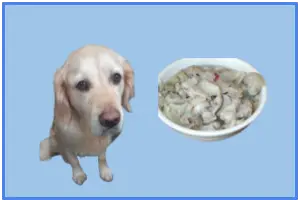Do you think that broccoli is more popular than cauliflower or visa versa?
Well, in 2019, every person in America ate just over 6 lbs (2.8 kg) of broccoli and just over 3 lbs (1.3 kg) of cauliflower.
So by my calculations, people are eating double the amount of broccoli than they are cauliflower.
Broccoli is the 10th most popular vegetable and cauliflower is the 14th most popular.
Of course, there are no statistics revealing how popular these two vegetables are with dogs, but I would imagine that this is a fairly popular combination.
After all, what appears on people’s plates often also appears in their dog’s bowls.
But should your dog be snacking on broccoli and cauliflower or should they avoid them like the plague?
Let’s find out.
The trouble with using nutrition data with dogs
Most of the foods that we eat have been analysed to see what nutrients they contain.
This information is freely available and very handy to nerds like me.
But the information isn’t perfect because it is calculated to meet the needs of people, not dogs.
It doesn’t mean that the information is useless- far from it.
It is just something to bear in mind.
Broccoli nutrition data

So when we looked at the nutrition facts for raw broccoli, in every 100 g, it contains 34 calories, has 0.4 g of fat, 33 mg of sodium, 6.6 g of carbohydrate and 2.8 g of protein.
Vitamin and mineral wise it is a great source of vitamin K and vitamin C in particular.
So that I don’t repeat myself, I will describe in detail later how these minerals and vitamins play an important part in keeping our dog’s healthy.
Although the majority of us tend to just eat the florets of broccoli ourselves, when it comes to your dog don’t forget that the stem and the leaves are equally nutritious.
Now let me move onto cauliflower.
Cauliflower nutrition data

On the other hand a 100g serving of raw cauliflower, contains 25 calories, 0.3g fat, 30 mg sodium, 5g of carbohydrates and 1.9 g of protein.
In terms of vitamins and minerals, a cauliflower has a fair amount of these but not as many as broccoli has.
Like broccoli, cauliflower has an image problem.
And the problem is that most of us eat the white florets and we discard the leaves.
In an article that I have just recently written, I wrote about why cauliflower leaves are so nutritious for dogs.
Broccoli is so powerful because it is dark green.
A sign that a vegetable is bursting with vitamins and minerals.
In the next section, I want to put these two vegetables head to head.
Broccoli vs cauliflower (vitamins)
I don’t expect any of you to remember any of the specific values from the vitamin and minerals that can be found in these two vegetables.
Don’t worry, there won’t be a test!
But I wanted to do a quick comparison between them.
Do they contain the same vitamins or minerals or are they slightly different?
Firstly, the vitamins.
The only two vitamins that cauliflower has more of than broccoli is pantothenic acid and vitamin B6.
For every other vitamin, like for like, broccoli steals the show.
And by quite some margin.
For instance it contains almost double the amount of vitamin C than cauliflower, ten times the amount of vitamin E and seven times the amount of vitamin K.
| Vitamin | Broccoli | Cauliflower |
| Folate (mg) | 63 | 57 |
| Niacin (mg) | .639 | .507 |
| Pantothenic acid (mg) | .573 | .667 |
| Riboflavin (mg) | .117 | .060 |
| Thiamin | .071 | .050 |
| Vitamin A (mg) | 417 | 0 |
| Vitamin B12 | 0 | 0 |
| Vitamin B6 (mg) | .175 | .184 |
| Vitamin C (mg) | 89 | 48 |
| Vitamin E (mg) | .78 | .08 |
| Vitamin K (mcg) | 101 | 15.5 |
Broccoli vs cauliflower (minerals)
So below is a comparison table for the minerals that are found in broccoli and cauliflower.
And, as with the vitamins, pound for pound, broccoli contains more minerals than cauliflower.
This includes double the amount of calcium, almost double the amount of iron and four times as much selenium.
| Mineral | Broccoli | Cauliflower |
| Calcium (mg) | 47 | 22 |
| Copper (mg) | .049 | .039 |
| Iron (mg) | .73 | .42 |
| Magnesium (mg) | 21 | 15 |
| Manganese (mg) | .210 | .155 |
| Phosphorous (mg) | 66 | 44 |
| Potassium (mg) | 316 | 299 |
| Selenium (mcg) | 2.5 | .6 |
| Zinc (mg) | .41 | .27 |
How much broccoli and cauliflower should I feed my dog?
For most dog owners out there, we are looking to add broccoli and cauliflower to our dog’s existing (complete) diet whether that is from a can or from a bag of kibble.
If you are asking about broccoli and cauliflower because you are thinking of creating your own homemade diet from scratch, then that is beyond the scope of this article.
And that is because there are just so many different parts to consider.
For the rest of us, any combination of broccoli and cauliflower that you add to your dog’s food should not exceed more than 10% of their total amount of food.
I don’t think there is a need to be too scientific about this, you can roughly guess 10% by using a tablespoon or serving spoon and serving slightly too much or too little won’t harm your dog in the slightest.
How much broccoli and cauliflower for a first time user?
If you are introducing broccoli and cauliflower to a dog for the first time then only introduce one vegetable at a time and start off with a small amount.
And in fact, I would introduce cauliflower first, because as we have seen from the data above, cauliflower is less potent.
This gives you a chance to see how your dog (and their stomach) reacts to one vegetable.
If that process goes well, then introduce a small amount of broccoli on its own to your dog and see how it goes.
If it goes swimmingly, then you can start adding a mixture of the two vegetables to your dog’s food.
Why am I urging such caution?
The reason is that if you jump in at the deep end and start feeding your dog a combination of broccoli and cauliflower and if your dog has an upset stomach from it, you don’t know why.
Whereas a more cautious introduction will help you spot problems faster.
Can my puppy eat broccoli and cauliflower?
Broccoli and cauliflower are great “add ons” for your puppy.
Don’t add anything until your puppy is 100% weaned and until they are a confident and happy eater with the diet or food that you have put them on.
Puppies are delicate and highly distracted little things.
If you have a puppy that is a picky eater then ask your other dog friends or phone your for some advice.
Adding broccoli and cauliflower to their diet probably won’t make them less picky, it will just confuse them even more.
So sort out that part of the diet first.
Once you have mastered that, then feel free to introduce your puppy to new foods.
As I said earlier, start with very small amounts of cauliflower first and give them lots of time to just get used to that.
Puppies tend to have more sensitive stomachs than adult dogs and new ingredients might cause a shock to the system.
Keep a close eye on their stool.
Then slowly introduce them to broccoli before combining the two vegetables.
Feed broccoli and cauliflower: raw or cooked?
My dogs will happily eat a range of raw vegetables and that is how they are with broccoli and cauliflower.
I tend to just cut it up roughly into 1cm cubes and then mix it in with their main meal.
Sometimes, I will give them a much larger chunk of broccoli or cauliflower stalk but since they are old timers with these two vegetables, I don’t have to worry about them becoming a choking hazard.
If your dog likes to inhale their food rather than chew it, you might be best to stick with the smaller chunks.
If your dog spits out raw vegetables, then the best way of preparing it is to steam it for a few minutes.
Steaming broccoli or cauliflower doesn’t destroy too many nutrients and some dogs are happier when there is less crunch.






